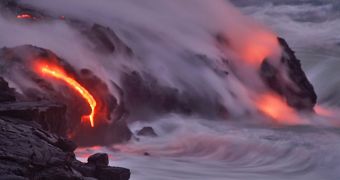An active volcano located on the largest island in the Hawaiian archipelago has been unceasingly spewing lava into the ocean for some days now, the contact between haze and waves creating an astonishing scenery.
Authorities say the phenomenon could attract a large number of tourists if it doesn't stop in the next days, First Post reports.
The Kilauea Volcano located on the Big Island of Hawaii has been performing a ceaseless eruption ever since 1983, but the lava wasn't also reaching the ocean.
This Saturday was the first time when the flow got into the ocean again, after a similar event last December.
“Ocean entries can be quite beautiful but also quite dangerous,” said Janet Babb, a spokeswoman at the Hawaiian Volcano Observatory of the US Geological Survey in a statement meant to warn the potential visitors of the dangers presented by the natural performance.
She advised tourists to respect the distance limit marks encircling the lava flow for their own safety.
Not only is the immediate proximity of the lava dangerous, there is a large area to be avoided around it, since the flow causes a large splash of lava hunches and hot water.
“The molten lava meeting the ocean creates Steam which may look innocuous, but can be quite hazardous,” Janet Babb warned.
“It’s acidic and contains tiny particles of volcanic glass. And waves crashing with the lava can send out scalding water.”
The authorities had security workers placed around the risky area to make sure visitors don't venture there.
Officials declared no locality in the volcano's neighborhood has suffered any damages, nor are there signs of a future threat.
The possible duration of the lava flow hasn't been yet estimated by experts, neither has the number of expected tourists announced by officials. However, the latter's increase is certain.
“A lot of people want to see a live lava flow,” said George Applegate, director of the Big Island Visitors Bureau.

 14 DAY TRIAL //
14 DAY TRIAL //